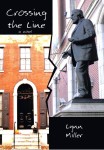Background: CROSSING THE LINE
(December 2010)
"Who would have guessed in 1970," a friend recently mused, "that forty years later, it would still be illegal to possess marijuana almost everywhere in America, but that same-sex marriage would be spreading across the land?"
Who, indeed? My friend's question captured my earlier impulse to write Crossing the Line. You have to be amazed at what both has and hasn't changed in attitudes toward a host of social issues over four decades. Who would have guessed in 1970 that in forty years, the President of the United States would be an African-American? But, if you look at it the other way around, who wouldn't have guessed that this man whose parentage is equal parts white and black is universally considered to be black, not white, just as in the days of slavery and segregation, when anyone with a "drop" of Negro blood was classified as black?
So it is for gays, who are "out" in a way that would have been inconceivable forty years ago. Yet, in that same period, they were first ostensibly banned from military service, then subjected to eighteen years when they might serve their country in its armed forces only if they lied about their sexuality, and finally to the eureka moment at the end of December, 2010, when the demeaning "don't ask, don't tell" policy finally was overturned.
Still, the repeal of D.A.D.T. brought some Republican opponents in the Senate almost to apoplexy, as if the struggle to extend equal rights to all Americans doesn't explain everything fine in the nation's history. Weeks before, it was white-hot prejudice, a refusal to see the status of gays as a civil rights issue, that brought about the recall of three Iowa judges who'd had the temerity in 2009 to uphold equal marriage rights for same-sex couples. Through progress and setbacks, a great many Americans still seem to believe that homosexuality is an illness. (If that's so, as one wag suggested, should gay folks just report out sick to their employers with the excuse, "I'm still gay"?)
In Crossing the Line, to put these contrasts and continuities in even bolder relief, I chose to look at social change and prejudice in America over a century and a half. Charles Darwin's revolutionary scientific work serves as backdrop and subtext for the novel. Its 19th-century story is of Darwin's own contemporaries. The central, modern story unfolds nearly 200 years after the great scientist's birth and 150 years after he published On the Origin of Species. Today, when creationists and Quran-burners light political storms, how quaint are the words of the man who wrote to Emma Darwin at her husband's death, "I trust you are consoled to know that because Darwin lived, humanity shall never more be cursed by the superstitions of the past."
Although Crossing the Line is a work of fiction, one central character, Hiram Milhouse (1832-1886) is drawn largely from the professional life of Joseph Leidy (1823-1891). Leidy was a giant in science in his day and an early supporter of Darwin in America. He served as president of Philadelphia's Academy of Natural Sciences. His statue now greets visitors outside the Academy's entrance--and serves as the cover illustration for Crossing the Line. Other historical figures are also woven into the story, giving a context and immediacy to the lines between past and present, fact and fiction, that emerge when generations discover the mysteries that bind them together.
Lynn Miller


